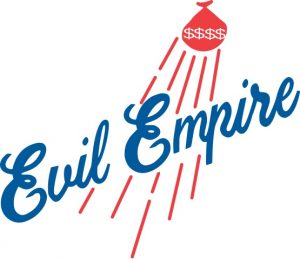
What follows is the transcript of a press conference convened in the early hours of Monday, July 10, in the Yankee Stadium press room. The press had gathered to hear from Hal Steinbrenner, chairman and managing general partner of Yankee Global Enterprises; Brian Cashman, general manager of the New York Yankees; Aaron Boone, field manager of the New York Yankees; Aaron Judge, team captain of the New York Yankees; Derek Jeter, Hall of Fame shortstop and Captain Emeritus of the New York Yankees; Jason Zillo, vice president of Communications and Media Relations for the New York Yankees; and Hank Waddles, writer for the New York Yankees blog, Bronx Banter.
Zillo: Ladies and gentlemen of the press, thank you so much for being here on what should be a rare off day for all of you. With that in mind, I’m going to hand things over immediately to Mr. Steinbrenner.
Steinbrenner: Thank you so much, Jason. I think everyone here knows that success and failure here is measured by only one metric. My wife and I were vacationing recently at a villa in Northern Italy, and I just couldn’t take any more of these reports I was getting from the states. The losses. The struggling offense. I knew that my father wouldn’t have been able to stomach it. You know, people don’t think I hear the criticism, but I do. I know that people think I’m not my father, that I don’t want to win the way he did, but let me tell you… So I got Cash on the phone, and I told him enough was enough.
Cashman: I can confirm all of that. Mr. Steinbrenner — this Mr. Steinbrenner — wants to win just as badly as his father did. Even more so, I think sometimes. So we’re making some changes at the organizational level. It’s unusual for any team, especially for this organization, to make sweeping changes in the middle of the season, but here’s why…
[Cashman takes a large championship ring off of his finger and forcefully bangs it on the table in front of him before continuing.]
Cashman: This is ring #27, from 2009. I look at this ring every night before I go to sleep, and I can’t believe it’s been fourteen years since our organization won this ring. Four. [click] Teen. [click] Years. [click]. And it’s not good enough. So I decided to look in the mirror, and I realized that I have to take some responsibility. Maybe I have to step back.
Jack Curry: Are you resigning?
Steinbrenner: Brian is not resigning, and he hasn’t been fired. We’re just reimagining things. I think I’ve come up with a way to help the office run more smoothly. We’ll have co-general managers going forward.
Brian Hoch: How can that possibly work? Who’s in charge? Is this new guy the assistant general manager, or the assistant to the general manager?
Steinbrenner: Again, these are co-general managers. Brian will be in charge of big picture decisions (budget, salaries, scouting) and his co-general manager — this morning we’re introducing Hank Waddles — will be in charge of the day-to-day stuff. Trades, roster decisions. He’ll also consult with Boone on lineup constructions and bullpen usage.
Curry: I’ve got two questions for Waddles. One, what makes you qualified for this position? Two, when can we expect to see some changes?
Waddles: Thanks for that question, Jack. First of all, I’m more than qualified. I’ve been watching Yankees baseball for more than forty years now. My entire life has been preparation for this moment. But really, this isn’t rocket science, which brings me to your second question. I’ve got some changes to announce right now.
First, we made a few transactions just a few minutes ago. Josh Donaldson has been designated for assignment. I don’t think I should have to explain that move to anyone here, but I will because it highlights a major change in this organization. If you look at the back of his baseball card, you’ll see that Donaldson was once a great player, but that’s no longer the case. I actually had a conversation with Boone about this. He keeps saying that Donaldson has had just one bad month, but it’s been more than bad. It’s been historically awful. In 99 at bats, he has ten home runs, five singles, and 31 strikeouts — balanced against just eleven walks. And this idea that this is just one bad month? In 132 games last year he was actually worse with an OPS of .682. This organization can’t have a player like that taking up roster space, so his locker is empty right now. I wish him well.
Next, we’re sending Billy McKinney and Franchy Cordero back to Scranton. We’re considering trade options for them, but you won’t see them in pinstripes again. They both filled in when they were needed, but I just don’t believe that they have anything else to offer. We’ve seen their ceilings. And just so you know where we’re headed, there are a couple other players you won’t be seeing in the Bronx any time soon — Willie Calhoun and Jake Bauers.
We’ve also called up Oswald Peraza from Scranton, which might not be that much of a surprise. Also, releasing Donaldson opens up a spot on the 40-man, and we’re filling that with Estevan Florial. He’ll be joining the team in Colorado and starting in left field. He’ll continue in that spot at least through the end of July.
Hoch: Can you explain your rationale for those moves?
Waddles: You know the rationale for those moves. First of all, we can’t continue to play D.J. LeMahieu every night and just keep telling each other that he’s better than what he’s shown. Well you know what he’s shown? He’s shown us exactly who he is, and there’s no sense putting him in the lineup every night just because of who we’re wishing he could be. Peraza has been playing third down at Scranton, and now he’s gonna play third for us up here. Just like Florial, he’ll have a thirty-game stretch to show us what he can do. We believe he’s gonna be great.
And Florial? That’s the easiest of all these decisions. This is a kid with a .985 OPS. I mean, NINE-EIGHTY-FIVE! What is he even doing in Scranton when we can’t score any runs in the Bronx? What else does this kid have to prove?
Cashman: To be honest, I had completely forgotten he was even in the organization until Hank reminded me this morning.
Steinbrenner: It really is the perfect example of big-picture-little-picture.
Waddles: He probably still strikes out a bit too much, but here we are at the all-star break and he’s got 21 home runs and 18 steals. There aren’t too many players in baseball with that type of a power-speed package, and since we’ve got a glaring hole in left field, this move is obvious. The organization placed bets on all these guys multiple times over the years when they decided against signing any of those marquee free agents, decided against including them in deadline deals that could’ve helped us in the short term. You can only hold your cards for so long. I believe it’s time to lay our cards on the table and see what happens. It’s been working well so far with Anthony Volpe, and we believe — I believe — it’ll work with this group as well.
Curry: What do these moves mean for Isaiah Kiner-Falefa? And is this a rebuild?
Waddles: This might surprise you, but I’m a big IKF fan. We’re lucky to have him. Booney and I have been talking, and I think he’ll still be in the lineup somewhere at least four or five nights a week. But this is definitely not a rebuild. We’re here to win games and win championships. Period. But what have we been doing so far in 2024? Who here feels like the old model was working?
Curry: A question for Aaron Boone. How do you feel about all this? It seems like you’ve lost some of your autonomy.
Boone: You know, that’s not how I see it. Hanky and I spent some time this morning…
Waddles: Never call me that.
Boone: Sorry about that, it’s just a tendency. Hank and I spoke this morning for a while when we met, and here’s what strikes me about him. I really like his compete. You know, he’s gonna get after it. I’m not worried about this at all — our working relationship or this team in general. I mean, I’m excited! Right? We’re in a position to get everything we want. It’s all right there in front of us, and with our rotation coming together — for the first time really — gosh, I’m just excited! And Hank’s got some great ideas.
Waddles: And here’s another one. Giancarlo Stanton is our right fielder. End of discussion. We’ll get him off his feet a couple times a week and give him a DH night, but he’s our right fielder. So through the rest of this month and into August, here’s the lineup you’ll see:
C Higashioka/Treviño
1B Rizzo
2B Torres
3B Peraza
SS Volpe
LF Florial
CF Bader
RF Stanton
DH LeMahieu
But we’ll roll IKF through second, third, and the outfield spots to give guys time at DH. I’d imagine IKF will start more games than D.J. Doesn’t that sound about right, Aaron?
Boone: Yes, that’s what we talked about. Again, I really like the looks of this lineup.
Waddles: Oh, and another thing — the Martian will be landing on September 1st, guaranteed, and he’ll be playing. It seems like the Yankees have been the only team in baseball that’s afraid to bring up young prospects, but that stops now. I mean, the only reason he isn’t coming up right now is that we’ve got Florial and Peraza ready to contribute. But you can mark your calendars right now — Jasson Dominguez will be in the starting lineup on September 1st. To help move him along, we’re moving him up to Scranton today.
Hoch: And what about when Judge returns? How will he impact all this?
Judge: Maybe I should answer that. What everyone knows but is afraid to say out loud is this — I don’t know if I’m gonna be back out on the field this season. No one knows. This team can’t afford to wait for me, they’ve got to get out there every night and compete, and this line up gives us the best shot at that. If I can get back sometime in August or September, I’ll just fit in wherever and whenever Hank and Aaron — hey, did you hear that? Hank… Aaron? Anyway, I’ll be happy to jump in wherever they feel like I can help the team.
Curry: I’m wondering something else. Derek, why are you here this morning? What’s your role in all this?
Jeter: No reason, really. No role. They mentioned that I was always Hank’s favorite player, so I thought it would be cool to stop by and say hello.
Waddles: Yes. It’s been very cool. Now let’s get to work.





























